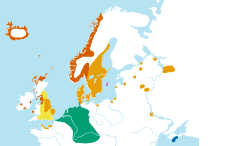
Back Старажытнагутнійская мова Byelorussian Henc'hutneg Breton Gotlandès antic Catalan Starogotlandština Czech Gammelgutnisk Danish Altgutnisch German Gotlanda lingvo Esperanto Gútnico antiguo Spanish Vanagutni keel Estonian Muinaisgutniska Finnish
This article includes a list of general references, but it lacks sufficient corresponding inline citations. (February 2020) |
| Old Gutnish | |
|---|---|
| Region | Gotland |
Indo-European
| |
| Language codes | |
| ISO 639-3 | None (mis) |
non-gut | |
| Glottolog | gutn1238 |
| IETF | non-u-sd-sei |

| Part of a series on |
| Old Norse |
|---|
 |
| WikiProject Norse history and culture |
Old Gutnish or Old Gotlandic[1] was a North Germanic language spoken on the Baltic island of Gotland. It shows sufficient differences from the Old West Norse and Old East Norse dialects that it is considered to be a separate branch. While vastly divergent from Old Gutnish and closer to Modern Swedish, a modern version of Gutnish is still spoken in some parts of Gotland and the adjoining island of Fårö.
The root Gut is identical to Goth, and it is often remarked that the language has similarities with the Gothic language. These similarities have led scholars such as Elias Wessén and Dietrich Hofmann to suggest that it is most closely related to Gothic. The best known example of such a similarity is that Gothic and Gutnish called both adult and young sheep lamb.
The Old Norse diphthong au (e.g. auga "eye") remained in Old Gutnish and Old West Norse, while in Old East Norse – except for peripheral dialects – it evolved into the monophthong ǿ, i.e. a long version of ø. Likewise the diphthong ai in bain ("bone") remained in Old Gutnish while in Old West Norse it became ei as in bein and in Old East Norse it became é (bén). Whereas Old West Norse had the ey diphthong and Old East Norse evolved the monophthong ǿ) Old Gutnish had oy.
| Proto-Germanic | Old Gutnish | Old West Norse | Old East Norse |
|---|---|---|---|
| *augô (eye) | auga | auga | auga > ǿga |
| *bainą (bone) | bain | bein | bæin > bén |
| *hauzijaną (to hear) | hoyra | heyra | høyra > hǿra |
Most of the corpus of Old Gutnish is found in the law of the Gutes (Old Gutnish: Guta lag) from the 13th century.
- ^ Swedish at Ethnologue (18th ed., 2015) (subscription required)